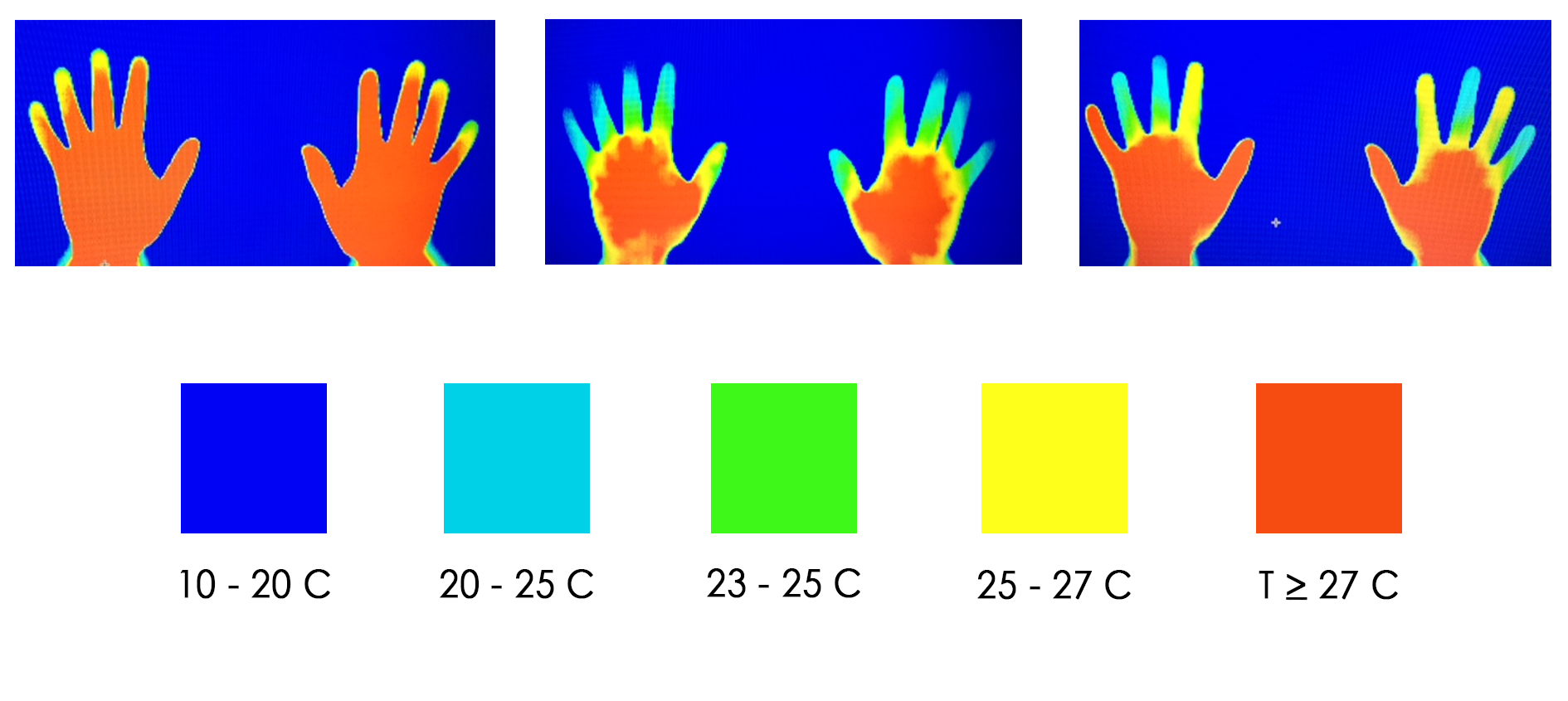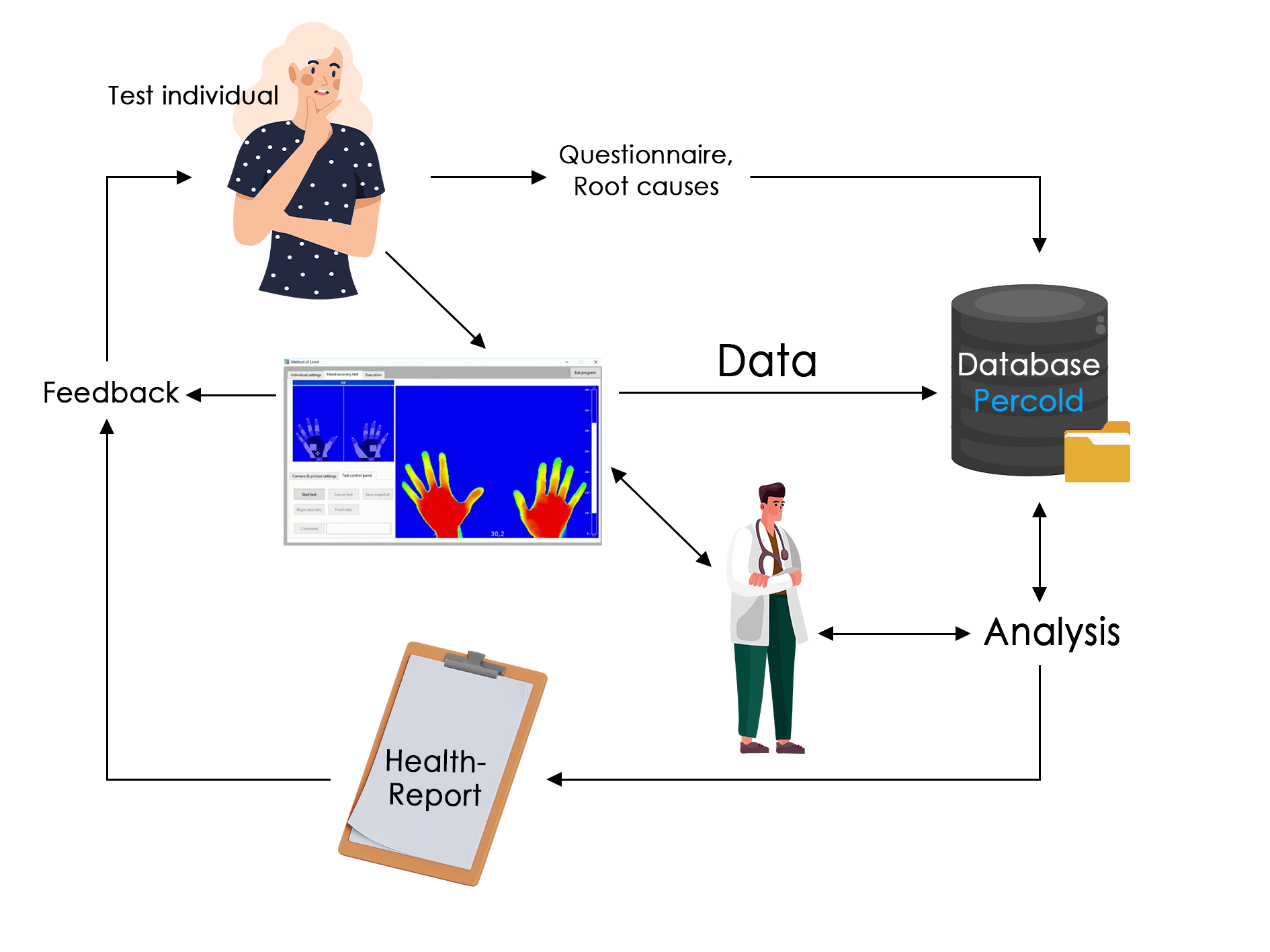Measurement of peripheral blood circulation
The MoL measurement method is patented in Sweden, Norway, the United Kingdom, Germany, Canada, the USA, and China.
About the measurement method
MoL is a mobile e-Health solution that can be implemented at the workplace to minimize production losses. MoL ensures the storage of data and documentation, analysis, real-time results, and data validity.
Reduced circulation in the hands, feet, and face can lead to diminished functional ability in the form of poorer concentration, speech ability, as well as decreased balance and coordination skills. Blood pressure rises and puts strain on the heart. The risk of ill health, injuries, and production losses increases.
Vibration exposure at work can lead to discomfort in the hands and arms due to vascular and nerve damage. This can manifest itself as Raynaud's syndrome, paresthesias (numbness), and carpal tunnel syndrome. This can be detected by measuring and analyzing deviations in peripheral blood circulation.
MoL can measure the effects of using vibrating tools, drugs, and tobacco. It can also be used in product development, for example, to evaluate a new design for gloves or personal protective equipment.
With the help of a thermal camera, it is possible to see areas with poor circulation, which means that preventive and alleviating measures can be implemented so as not to exacerbate the injuries.
The method is scientifically structured and displays information quickly in an educational manner. Immediately after the measurements are completed, data is sent to a database where it is stored, analyzed, and presented in a predefined health report that medical personnel can open, comment on, provide recommendations, and return to the test unit, as shown in the figure below.
Metoden är vetenskapligt uppbyggd och visar information snabbt på ett pedagogiskt sätt. Omedelbart efter att mätningarna är klara skickas data till en databas där de lagras, analyseras och presenteras i en fördefinierad hälsorapport som medicinsk personal kan öppna, kommentera, ge rekommendationer och återvända till testenheten, som visas i figuren nedan.

Summarized measurement process
MoL identifies any impairments in several zones on the fingers by measuring the warming process after a mild cooling of the hands in a cold water bath.
The average temperature in the zones is measured every 10 seconds for 10 minutes. Measurement data is transferred to a database for automatic storage, analysis, and report generation. The results are delivered in real-time.
During and after the test, tips are provided on measures that can be taken to prevent and possibly alleviate circulation impairments, as well as how one can increase circulation in the hands using simple methods.

How the measurements are conducted
- Before the test, the test subject sits at rest for 30 minutes at room temperature of +20°C, without touching cold or warm surfaces.
- Data and answers about blood pressure, pulse, body temperature, and room temperature are fed into the measurement program. There's always a written agreement, and if the data is stored in the database, it does not have the test subject's personal identification number.
- The measurement program suggests an individual code for the person being tested. No personal data is saved in the database. If the person wishes to be tested again later to see if any change has occurred, the same code is used.
- The measurements start by measuring the initial temperature (after 30 minutes of rest).
- Hands/feet are cooled in 10-degree water for 30 seconds.
- Recovery capability is measured as the average temperature in predefined zones every 10 seconds for 10 minutes.
- The measurement program sends measurement data to a database that stores, analyzes, and delivers data/decision support (in real-time) to a doctor who can comment and add medical recommendations, convert the health report, and send it back to the measuring unit and the test subject.
GOOD TO KNOW
When the body temperature drops below 36.5 ºC, the body starts to sacrifice the peripheral body parts, i.e., toes, fingers, and the tip of the nose.
- At -15 ºC, 90% of frost injuries to the hands occur.
- The problem with chilled fingers is not that you can't move them, but that you can't control them.
- When you've frozen your big toe, you can have balance issues because the big toe supports 40% of the body weight.
- Smoking lowers finger temperature by 4 ºC for 10 hours.
- Holding onto a cold metal handle can cause permanent frost injuries because metal is a conductive material that draws away heat.
Read about our previous measurements and analyses
Omicold can offer its customers a unique comprehensive solution and decision support with results that improve performance, raise safety awareness, and reduce accidents and injuries.
Find customer cases from Skellefteå Kraft, the Police in Norrbotten, and Luleå Technical University on our blog page.
Why is a health profile needed and what does it look like?
With a health profile, we can group individuals into two different categories:
1. Those who fall within a normal distribution for "warm hands" who have good blood circulation and generate heat.
2. Those who fall within a normal distribution for "cold hands" are more sensitive to cold and have a poorer ability than "warm hands" to retain heat in their hands, especially in the fingers, when exposed to cold.
By knowing which health profile one belongs to, one can better prepare, for example, for work in cold environments and thus avoid risks of injuries such as white fingers.
Why do you need to know if you have good or poor circulation in your hands?
The hands are one of our most important tools and the body part with the most sensitivity.
With poor blood circulation in the hands, the sensitivity deteriorates, for example, you can't feel that a surface is rough, you become clumsy and drop things. If you are a biathlete, you can't feel the trigger. If the hands become very cold, you can move them, but you can't control them.
Why are there two groupings, those who recover and those who don't?
A theory is that it has to do with geographical adaptation, with those originating from subarctic conditions more likely to fall into the "cold hands" group.
Another theory as to why women are more represented in the "cold hands" group is that women's anatomy differs somewhat compared to men, who tend to prioritize preserving body temperature in the vital parts of the body.
This has not been scientifically established.
Can one see the effects of smoking/snus use?
If one has recently smoked or used snus, the blood circulation in the hands decreases because the vessels constrict.
During the measurements, it is observed that the fingertips become colder. The effect can persist up to 4 hours after smoking or using snus.
Can one see the effect of medication?
Yes, effects of medications such as blood pressure drugs and pain relievers have been observed.
Blood pressure medications tend to raise hand temperature while some pain relievers have the opposite effect.
Can one see reduced circulation?
Yes, and to ensure that it is a reduction, several repeated measurements are taken.